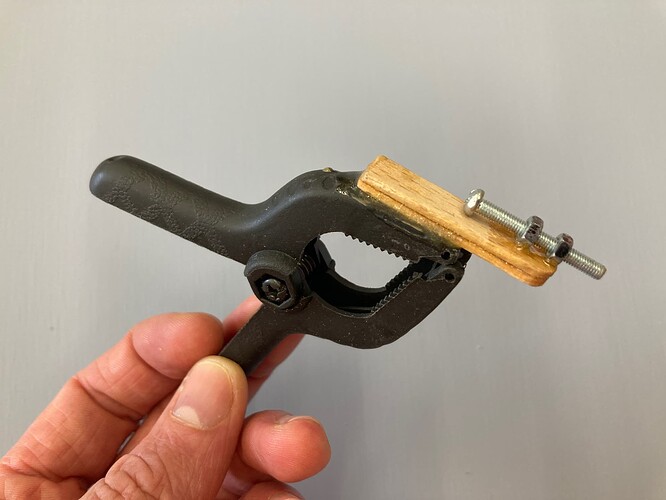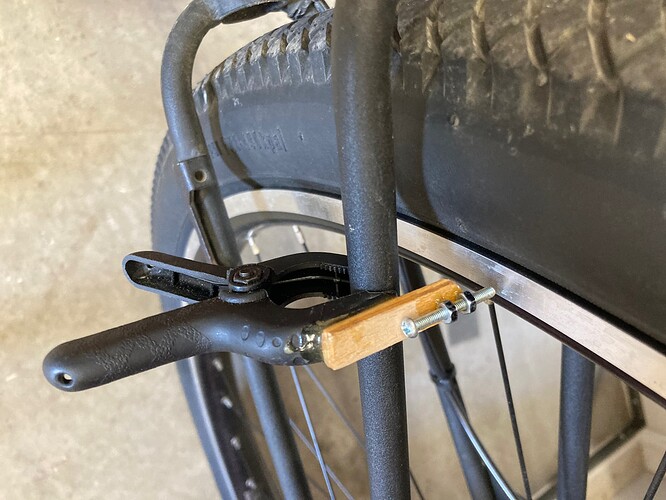Hi everyone,
I’ve been checking over my relatively new Oracle 29er Muni and the spokes seem to me on the loose side. I’ve not experienced any issues with this but I am considering getting them tightened.
Q1. Do they need to be firmly tightened?
Q2. If you’re a practically minded person would you do this yourself or take to a bike shop?
Q1: They need to be uniformly tensioned per side. This depends on spoke diameter and material. Josh at UDC says standard 2.0mm stainless steel spokes should be at 95kgf.
Q2: Two options: take it to a bike shop or buy a Park TM-1 tension meter and do it yourself. I bought a TM-1 and think it’s a really excellent tool to have. FYI - 95kgf translates to ~23 on that tool.
I would buy a tensiometer. I didn’t spring for the Park meter, but the cheap Amazon model I got was around $20 and gives very consistent readings. It’s a nice tool to have that takes the guesswork out of things.
They need to be tightened with the right tension - not too firm, not too loose. The window between too firm and too loose is relatively large. I’ve never touched a tensionmeter, but built multiple wheels myself and they work just fine. If you don’t have superlight rims or hubs (and the Nimbus Dominator II rim that comes on the oracles is the opposite of that) and don’t put unusually high amounts of stress on your wheel, squeezing the spokes between your fingers and comparing it to a known good wheel is accurate enough in my experience.
Guess I answered this already. I do it myself - I won’t pretend that there has not been a bit of trial and error, but I used to ride a lot more street and flatland, where wheels inevitably suffer, taking it to a bike shop every few weeks would have been way too expensive.
A few mistakes to watch out for are:
- Starting with too big of a change (keep it to quarter turns at a time). It’s easy to underestimate how much tighter the wheel will be once you’ve tightened all 36 spokes. When you tighten the first one it often doesn’t feel like it has changed much, but the spokes all influence each other. It’s better to do 2 rounds of quarter turns than to start with half turns and noticing your wheel is now way too tight half way through.
- Loosing track of where you started. Wrap a piece of tape around the first spoke you tighten, start at the valve, whatever makes sure that you know which spokes you already tightened and which ones you didn’t.
- Loosing track of eveness. (Probably not a big concern for you when you just retighten a factory built wheel). Make sure the wheel is still centered in the frame, and I’d always recommend evening out spoke tension first, then tightening the wheel.
If you keep an eye on it and don’t do anything too demanding, I don’t think you can do much harm. Really the big killer is having uneven tension, that can lead to broken spokes and bent rims - but what exact tension works is a relatively large window.
I tap each spoke with a screwdriver once they are all about as tight as I want and then listen carefully for any great difference in sound. This has worked well on the two wheels I’ve built so far.
I tore down the wheel on my daughters unicycle so that I could paint the rim and the hub and then reassembled it just going slow with quarter turns and a little bit of truing. Later when I got the tensiometer I measured the tension on each spoke and it was remarkable how even they were. So in my experience I don’t think a tensiometer is necessary, but I’m glad I’ve got it.
Unfortunately tension meters like the Park TM-1 can only give you absolute values if they’re calibrated:
- Hang a weight representing the desired tension from a spare spoke of the same length, gauge and material as those on the wheel.
- Measure the spoke deflection using the tension meter, noting the number on the scale.
- Bring the spokes in the wheel up to the same number on the tension meter.
Without this calibration step it’s really just guesswork. You can still use the meter to determine relative tension, but it’s quicker and easier to do that by feel and sound.
Adjusting tension by pitch sounds too much like a wild ass guess to me. I’m sure someone with plenty of experience and a good ear can do it effectively, but I have neither. I know that after attempting to adjust the tension on my Quax by ear and then putting a tensiometer on the spokes that there was a large variation between them.
I used to do musician things in a past life, and tuning spokes by ear feels very similar to tuning a guitar by ear. It didn’t occur to me that it might be a learnt skill, oops.
I’ve never had any musical experience but I tune spokes by ear and feel just fine. I haven’t taken a tensionmeter to my wheels as I don’t have one but after a bit of abuse over a few months the wheel hasn’t gotten out of true by any notciable amount according to the trusty zip tie (same one used for building the wheel, truing stands are too fancy for my budget).
I’ve never been very good at tuning a guitar either. Sure, I know how to do it, but everybody else seems to think it still sounds out of tune afterward. I’ve got similarly bad timing. I really like music, but I seem to have zero talent for it.
Musical ability probably would have helped me learn Chinese too……
I’m a fan of learning to deal with it yourself.
It’s not that hard and kinda fun.
Parktool has a great app that lets you enter your spokes tension #'s and it gives you a visual graph to help you along and it also keeps your wheel’s measurements for future use.
Unfortunately I don’t have my Oracle’s #'s anymore otherwise I would share.
I use a Park TM-1 as well.
Don’t forget that you have two different lengths of spokes to work with on your Oracle.
+1 For the ziptie truing method. I’ve been doing that for years. You don’t even need to cut them accurately. Just cut them a tiny bit too long and rotate them so that they only touch the out of true spots and keep reducing the clearance as you go. It took me a long time to realize there is a 3rd dimension to truing a wheel and you don’t just want to true it up left to right, but vertically as well. Fortunately, zip ties are good for checking that too.
I made a little gadget for field truing. It’s not strictly necessary but it does make life easier.
At home I use a truing stand, because good tools are a pleasure to use.
The Unior 1752/2 comes with a calibrator. It’s a small rod that shall give a given reading in the tool when the tool is correctly calibrated.
Edited: Sorry, that was not the Park TM-1. It was the Unior 1752/2

Here’s my wheel trueing stand! Fits all wheels, easily adjusted and can be stored behind your ear once adjustments have been made!
I’ve been building wheels for over 25 years (and when I was racing mountain bikes I was building and truing wheels all the time), and I use my thumb on the frame. Instead of the on/off of a feeler touching or not touching, you can feel the pressure change, so it’s super sensitive.
I have the other tools - a dishing tool, a tensiometer, a special nipple screwdriver, half a dozen spoke wrenches - but I’ve never wanted a truing stand.
I find this is an excellent source of information
Advocates the musical way but explains rhe tensiometer, too.
A few $, €, £ well invested if you are keen to build and maintain wheels on a uni, bi, tri or whatever number wheeled human powered cycle.
Probably works for old cars with spokes too.


